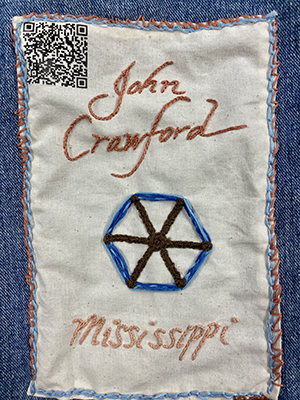John Crawford
“I spent four years on my knees in the weaving house. I threw the shekel for the old Mistress to weave. Some of the women spin, some card, and some weave. I remember some made a cloth with three strands of cotton and two of wool. Mistress had a fine spinning machine and everytime it spun a hundred and fifty yards of thread, it go double click. We measured yarn by the hanks. A hank and a half was a yard. I got the whirring noise in my ears now from the spinning wheels.” – John Crawford
All around the mulberry bush, the monkey chased the weasel.
The monkey thought ’twas all in fun. Pop! goes the weasel.
A penny for a spool of thread, a penny for a needle.
That’s the way the money goes. Pop! goes the weasel.
 Najla Khan ’25
Najla Khan ’25
“The weasel” in this nursery rhyme refers to the wooden mechanism on a spinner’s reel, a spoked wheel that is used to prepare yarn or thread for warping on the loom. Children were often given the task of cranking this tool, which made a popping sound when the right amount of yardage was measured out. The “mulberry bush” indicates that this rhyme was probably composed after 1718 when the first factory in the world was built to spin silk in England. (mulberry leaves are the only food source for silk worms). Work songs have a long and rich history in African American culture. Dakota Pippins, president of Harlem Late Night, jazz wrote:
“Most agricultural work songs were rhythmic a cappella songs intended to increase productivity while reducing feelings of boredom. The rhythms of work songs, similar to African drum beats, served to synchronize physical movement in groups and coordinate sowing, hoeing, and harvesting” This incredible legacy of oral tradition gave birth to a multitude of music genres we enjoy today: jazz, blues, rock & roll, and rap.
Sources
- Plantation Slave Weavers Remember: An Oral History, edited by Mary Madison
- Lombe's Silk Throwing Mill: The First Factory : History of Information
- It's 'Pop Goes the Weasel' for Old-Style Spinners - The Washington Post
- WORK/FIELD SONGS – Jazz History Tree
